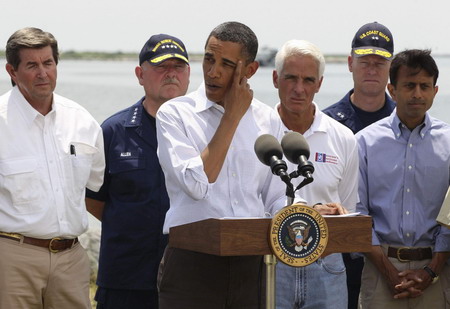Asia-Pacific
Obama and BP CEO visit Gulf as spill remains unsolved
(Agencies)
Updated: 2010-05-29 10:13
 |
Large Medium Small |
|
|
GRAND ISLE/HOUMA, Louisiana - BP said on Friday it may need two more days to know if its complex maneuver to plug a gushing Gulf of Mexico oil well has worked, while President Barack Obama warned there was no "silver bullet" solution to the biggest oil spill in US history.
BP CEO Tony Hayward flew over the Gulf to where his crew and robots worked on the "top kill" -- the injection of heavy fluids, materials and ultimately cement to seal the well one mile below the surface.
Hayward said the procedure was making progress choking off the five-week-old leak that has already spewed millions of gallons (liters) of oil into the Gulf.
"We have wrestled it to the ground but we haven't put a bullet in its head yet," Hayward told Reuters while aboard a helicopter over the spill site in the Gulf.
When the top kill began on Wednesday, BP said it would need up to 48 hours to gauge its success. But Hayward extended the timeline another 24-48 hours on Friday.
He said the top kill's chance of success remained at 60 to 70 percent.
BP has called the effort to plug the hole "a "rollercoaster ride," and investors might say the same. BP shares lost 5 percent on Friday, erasing gains made on hopes for a successful top kill, which aims to eventually seal with cement the ruptured well one mile below the surface.
On his second visit to the Gulf in the five-week crisis, Obama faced his own steep challenge to convince Americans that he was in command as frustrated Gulf Coast residents loudly criticized federal authorities for being slow to act and offering too little assistance.
"You will not be abandoned. You will not be left behind. We are on your side and we will see this through," Obama said in a televised statement after meeting local and state officials and inspecting the oil spill damage to the coastline.
"I am the president and the buck stops with me," he said.
BP 'Working for the government'
The buck may stop with Obama, but the key to stopping the environmental catastrophe lies with BP because the federal government has few tools to work at those depths.
Hayward, however, made clear that the government is in charge these days.
"We are working for the government," he said. "The government is running it."
BP views the top kill procedure as its best hope of plugging the well and containing a spill that has tarred its reputation and seen some 25 percent, around $50 billion, wiped off its share price.
The company said on Friday the cost of the disaster so far was $930 million. That figure is sure to multiply with cleanup of the oily mess, which is now larger than the spill from the Exxon Valdez disaster off the Alaskan coast in 1989.
As Hayward flew toward the site of the rig explosion that killed 11 workers on April 20, the sheen of oil and brown patches of crude and dispersant were visible below.
Some 50-60 vessels are in the area working on the BP containment and shut-off effort.
Hayward said BP had also injected a "junk shot" of heavier blocking materials, such as shredded rubber and golf balls, into the failed blowout preventer of the ruptured wellhead.
They were due to pump in more heavy fluids later on Friday. The mud has not stopped the oil leak but at times has slowed the flow.
BP began the top kill operation on Wednesday afternoon and then stopped pumping mud overnight to analyze pressure readings. It did not publicize the halt for many hours, drawing fresh accusations it was concealing information from the public. It denied the charges and blamed an oversight.
If the top kill fails, BP says it will try other remedies, such as a second attempt at containing the oil so it can be transported by pipe to a ship at the water's surface or placing a new blowout preventer atop the failed one.




